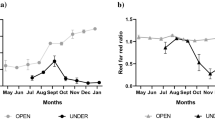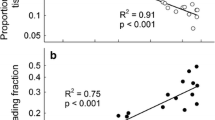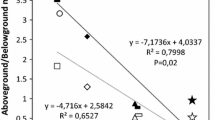Abstract
Plants can acclimate to shade through different processes. In particular, they can modify their biomass allocation and the architecture in order to increase light interception. The objective of this study was to evaluate the shade acclimation capacity of Festuca pallescens (St. Ives) Parodi, as part of research concerning the use of this species in silvopastoral systems in Patagonia, Argentina. Biomass allocation was estimated from the leaf and root dry weights of plants growing in an open pasture and forested plots. Crown architecture of plants growing in the open and in two shade treatments was studied dividing each plant in three concentric cylinders, within which leaf angles and leaf area were measured. Light interception of plants in each treatment was estimated from the projected leaf areas and the relative amount of radiation reaching each location. Biomass allocation changed significantly in plants growing under shade conditions, increasing the proportion of leaves relative to the roots (Leaf Mass Fraction = 0.29 (SD: 0.12) and 0.40 (SD: 0.09) in plants in the open and under shade, respectively). Also, mean leaf inclination angles changed in plants growing under shade conditions, allowing an increase in light interception of approximately 35% compared to plants with the crown architecture typical of the open treatment. Previous studies have shown that F. pallescens does not change its photosynthetic response to light under shade conditions. Therefore, we conclude that the reported changes in biomass allocation and crown architecture, in addition to the increment in specific leaf area explain the relatively high shade tolerance of this species.
Similar content being viewed by others
References
Allard G., Nelson C.J. and Pallardy S.G. 1991. Shade effects on growth of tall fescue: I-leaf anatomy and dry matter partitioning.Crop Science 31: 163–167.
Brouwer R. 1963. Some aspects of the equilibrium between overground and underground plant parts. Jaarboek van het Instotuut voor Biologisch en Scheikundig onderzoek aan Landbouwgewassen: 31–39.
Caldwell M.M. and Ross A.V. 1991. Root systems. In: Pearcy R.W., Ehleringer J., Mooney H.A. and Rundel P.W. (eds), Plant Physiological Ecology, Field Methods and Instrumentation, pp. 367–398. Chapman and Hall, London, UK.
Cruz P. 1997. Effects of shade on the carbon and nitrogen allocation in a perennial tropical grass, Dichanthium aristatum. J Exp Bot 306: 15–24.
Defossé G.E., Bertiller M.B. and Ares J.O. 1990. Above-ground phytomass dynamics in a grassland steppe of Patagonia, Argentina.J. Range Manage 43: 157–160.
Evans J.R. and Poorter H. 2001. Photosynthetic acclimation of plants to growth irradiance: the relative importance of specific leaf area and nitrogen partitioning in maximizing carbon gain.Plant, Cell and Environ 24: 755–767.
Fernández M.E., Gyenge J.E. and Schlichter T.M. (a) A simple model of stomatal conductance and leaf photosynthesis in Festuca pallescens (St. Ives) Parodi. Grass and Forage Science, submitted.
Fernández M.E., Gyenge J.E. and Schlichter T.M. (b) Growth of the grass Festuca pallescens in silvopastoral systems in a semiarid environment: Positive balance between competition and facilitation. Grass and Forage Science, submitted.
Jones H.G. 1992. Plants and Microclimate. A Quantitative Approach to Environmental Plant Physiology. 2nd Ed. Cambridge Univ. Press, Cambridge, UK, 428 pp.
Knapp A.K. and Smith D.L. 1997. Leaf angle, light interception and water relations. Demonstrating how plants cope with multiple resource limitations in the field. Am Biol Teach 59: 365–368.
Lambers H., Chapin III F.S. and Pons T.L. 1998. Plant Physiological Ecology. Springer-verlag, New York, New York, USA, 540 pp.
Monteith J.L. and Unsworth M. 1990. Principles of Environmental Physics. 2nd. Ed. Arnold, London, UK, 291 pp.
Moore C.W.E. 1964. Distribution of grasslands. In: Barnard C. (ed.), Grasses and Grasslands, pp. 182–205. MacMillan, London, UK.
Niinemets Ñ. and Fleck S. 2002. Petiole mechanics, leaf inclination, morphology, and investment in support in relation to light availability in the canopy of Liriodendron tulipifera. Oecologia 132: 21–33.
Poorter H. and Nagel O. 2000. The role of biomass allocation in the growth response of plants to different levels of light, CO2, nutrients and water: a quantitative review. Aust J Plant Physiol 27: 595–607.
Ryel R.J., Beyschlag W. and Caldwell M.M. 1993. Foliage orientation and carbon gain in two tussock grasses as assessed with a new whole-plant gas exchange model. Funct Ecol 7: 115–124.
Ryel R.J., Beyschlag W. and Caldwell M.M. 1994. Light field heterogeneity among tussock grasses: theoretical considerations of light harvesting and seedling establishment in tussocks and uniform tiller distributions. Oecologia 98: 241–246.
Schulze E.-D., Mooney H.A., Sala O.E., Jobbagy E., Buchmann N., Bauer G., Canadell J., Jackson R.B., Loreti J., Oesterheld M. and Elheringer J.R. 1996. Rooting depth, water availability and vegetation cover along an aridity gradient in Patagonia. Oecologia 108: 503–511.
Valladares F. and Pugnaire F.I. 1999. Tradeoffs between irradiance capture and avoidance in semiarid environments assessed with a crown architecture model. Ann Bot 83: 459–469.
Valladares F. and Pearcy R.W. 2000. The role of crown architecture for light harvesting and carbon gain in extreme light environments assessed with a realistic 3-D model. Anal Jard Bot Madrid 58: 3–16.
Author information
Authors and Affiliations
Corresponding author
Rights and permissions
About this article
Cite this article
Fernández, M.E., Gyenge, J.E. & Schlichter, T.M. Shade acclimation in the forage grass Festuca Pallescens: biomass allocation and foliage orientation. Agroforestry Systems 60, 159–166 (2004). https://doi.org/10.1023/B:AGFO.0000013276.68254.78
Issue Date:
DOI: https://doi.org/10.1023/B:AGFO.0000013276.68254.78




